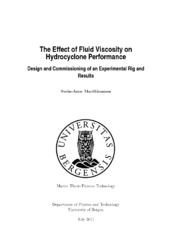| dc.description.abstract | Hydrocyclones are used in the process industry for a variety of applications. The product streams from the wells in the oil and gas industry include produced sand, which have to be removed as it interferes with control and instruments. There is also an environmental concern, which includes regulations for the content of hydrocarbons in the disposed sand. The existing knowledge of sand separation by cyclonic technology is largely limited to the separation from pure water. The future oil industry, however, faces challenges with heavy oil and non-standard particles. If the oil is heavy, the water-oil separation is poor and the sand therefore needs to be removed from a liquid phase with a considerable content of heavy oil. How the oil content will affect the cyclone performance is not understood or theoretically described. This thesis is mainly focused on solid removal from viscous liquids. An experimental rig has been designed and commissioned, and results from both experiments and CFD are presented. The results from this thesis include not only the affection of the fluid viscosity on the separation performance. It includes results for the pressure drop, and also the flow split distribution that we have when the hydrocyclone is operated with an underflow. As the viscosity of the carrier fluid increase, the separation efficiency decreases. The same is the situation with the pressure drop across the cyclone. When the viscosity of the fluid increase the pressure drop is reduced which is the opposite of what we would expect related to normal pipe flow. The by-pass ratio, which is the amount of suspension that exits through the apex of the cyclone, is increased at higher viscosities. The results from this thesis are highly valuable for the process industry. Even though more experiments are needed to fully understand the phenomena's described in this thesis, it is a leap in the direction of applying cyclonic technology in new areas. If the sand can be removed in a controlled and automated manner, the process systems can be operated with better control and safety. The lifetime of the equipment can be prolonged and allowing more sand to enter the production train can speed up the production. | en_US |
